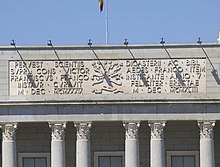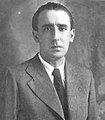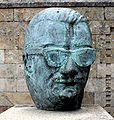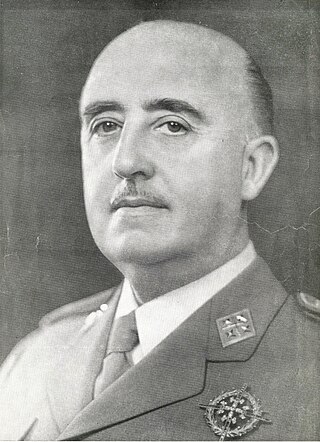Within Franco's Spain, and among artists in exile and in the image of Spain abroad, the Spanish Civil War (1936–39) was perpetuated as a reference to Spain's cultural life. The destruction of the Spanish artistic heritage had been of great magnitude, not only as a result of acts of war, but particularly by the iconoclastic fury of the Republican rearguard. These events were widely publicized in the new state, which in turn exhibited as an achievement its own recovery the most important collections of the Museo del Prado, except at Geneva, where Spain obtained from Vichy France two emblematic pieces from Spain under different circumstances ( La Inmaculada de Soult and La dama de Elche , 1941).
The cultural landscape
The literary production of intellectuals related to the new national government, although some international celebrities of great weight returned to Spain (Arturo Duperier, José Ortega y Gasset, Salvador Dalí) and minimal scientific activity was maintained (creation of the Institute of Political Studies (1939), CSIC (1939), and the Institute of Hispanic Culture (1946)) and some areas of relations (social gatherings such as the Café Gijón, magazines such as Vértice (1937 to 1946), Escorial (1940 to 1950), Garcilaso-Juventud creadora (1943 to 1946), Espadaña (1944 to 1951), Ínsula (launched 1946), Cántico (1947 to 1949), the long Spanish postwar recovery during the 1940s and 1950s created a cultural wasteland within the destroyed, hungry and isolated Spain, exacerbated by repression, the 'purification' of the educational system and cultural institutions, the purges of books, and widespread censorship. Compared with the preceding period, called the Silver Age (la Edad de Plata), shows one of the clearest contrasts in the cultural history of Spain. The term "cultural wasteland" or "intellectual wasteland", widely used, has itself been debated by many authors and may be unfair to the actual cultural productions; but it nevertheless has the virtue of connecting itself to the essentialist debate, pessimistic and inward-looking, on the 'Being of Spain', the existentialist view of the country, that was in itself the more important intellectual subject of the time.
From the history of science, the time has come to be known as the destruction of science in Spain. Possibly the most synthesized description is to be found among some novelists, poets and playwrights in their titles: Carmen Laforet with Nada (1945), Dámaso Alonso with Hijos de la ira (Sons of Wrath) (1946); Alfonso Sastre with La mordaza (The Bite) (1954); Luis Martín-Santos with Tiempo de silencio (Time of Silence) (1962); and Carlos Barral with Años de penitencia (Years of Penance) (1975).
Vicente Aleixandre, among the Generation of '27 poets and writers, best represented the vital, intellectual commitment to an interior exile, rich but hidden. Prominent representatives of the generation, such as Dámaso Alonso and Gerardo Diego, were involved in the Franco regime's cultural institutions, while others (Luis Cernuda, Jorge Guillén, Pedro Salinas and Rafael Alberti) went into an exile shared with a host of writers (Ramón J. Sender, Claudio Sánchez-Albornoz, Américo Castro, Corpus Barga, José Bergamín, León Felipe, Francisco Ayala, Max Aub, Arturo Barea, María Zambrano, Alfonso Daniel Rodríguez Castelao ('Castelao') writing in the Galician language, Josep Carner and Mercè Rodoreda writing in the Catalan language), scientists, artists and professionals from all disciplines whose international recognition was high in all types of universities and cultural institutions, culminating in the Nobel Prizes awarded to Juan Ramón Jiménez (literature, 1956) and Severo Ochoa (medicine, 1959). The granting of the same award in 1977 to Vicente Aleixandre featured the return to Spain of surviving exiles, who saw the international recognition of the restoration of democracy in Spain. Internal exiles who gained public recognition were Juan Gil Albert and Rafael Cansinos-Asséns.
The writers closely aligned with the Franco regime (Manuel Machado's brother Antonio, a living symbol of the fratricidal division; Eduardo Marquina, Eugenio d'Ors, Vicente Risco, Lorenzo Villalonga, Julio Camba, Wenceslao Fernández Flórez, Manuel García Morente, Tomás Borrás, Jacinto Miquelarena, José María de Cossío, the Marqués de Lozoya, Rafael Sánchez Mazas, Víctor de la Serna, José María Pemán (the 'minstrel of the Crusade'), Ernesto Giménez Caballero, Manuel Halcón, Juan Antonio Zunzunegui, Ángel Valbuena Prat, Eugenio Montes, Samuel Ros, Agustín de Foxá, Luis Rosales, José María Gironella, José Luis Castillo-Puche, Emilio Romero) or those who for one reason or another tried a compromise approach, with different reception from the regime (José Martínez Ruiz ('Azorin'), Jacinto Benavente, Ramón Pérez de Ayala, Carlos Arniches, bilingual Catalan language-writer Josep Pla, and have been mostly a common destiny in their assessment by subsequent literary criticism; relatively speaking, somewhat similar to the relegation and contempt suffered by intellectuals who supported the European Fascist regimes after their defeat (examples include Louis-Ferdinand Céline, Martin Heidegger and Ezra Pound). Others, such as Camilo José Cela and Pío Baroja, have been more fortunate.
The alignment on either side of the Spanish Civil War was becoming somewhat diffuse for a growing group of intellectual personalities, both in exile and within Spain, converging on what has been called the third (una tercera) of Spain. This is the case of Manuel de Falla and Ramón Gómez de la Serna (both resided until their deaths in Argentina, but are not identified specifically with either the exiles or with the Francoist authorities, who sought to recruit them), a significant group of Republican exiles to which violence had distanced them from the Republican side since the beginning of the war, called los blancos de París (the whites of Paris): Salvador de Madariaga, Niceto Alcalá-Zamora or Alfredo Mendizabal, and the Spanish Committee for Civil Peace, established in Paris in February 1937), and other significant groups who chose to stay in Spain or who returned in the early postwar years: the physician and essayist Gregorio Marañón or philosophers José Ortega y Gasset, Javier Zubiri and Julián Marías. Symbolically, the three main leaders of the Association of Service of the Republic of 1931 (Ortega and Perez de Ayala Marañón) agreed in its hopeless rejection of opposition and the resigned acceptance of the Franco regime, returning to Spain in the 1940s. Meanwhile, a select group of intellectuals from the left of Falangism distanced themselves from the regime (the environmentalist journal Escorial, which received the controversial liberal denomination "Falangism": Pedro Laín Entralgo, Antonio Tovar, Dionisio Ridruejo, Jose Maria Alfaro Polanco, Gonzalo Torrente Ballester, José Luis López Aranguren, and Álvaro Cunqueiro, who continued to write most of his work in the Galician language.
Something similar happened with the explicit position of a remarkable group of poets to "uproot" (Dámaso Alonso's expression) and leave the "garcilasista aesthetic", named after the official youth magazine Garcilaso-Juventud creadora: Luis Rosales, Luis Felipe Vivanco, Leopoldo Panero, in favour of social poetry (magazine Espadaña, from 1944 to 1951): Eugenio de Nora, Victoriano Crémer, who is associated with the subsequent careers of Gabriel Celaya and Blas de Otero, usually identified with the internal exiles, or a group of novelists labelled "tremendistas" (Tremendismo literary movement): Camilo José Cela, La familia de Pascual Duarte (1942), Rafael García Serrano, Luis Landínez, Darío Fernández Flórez.

































